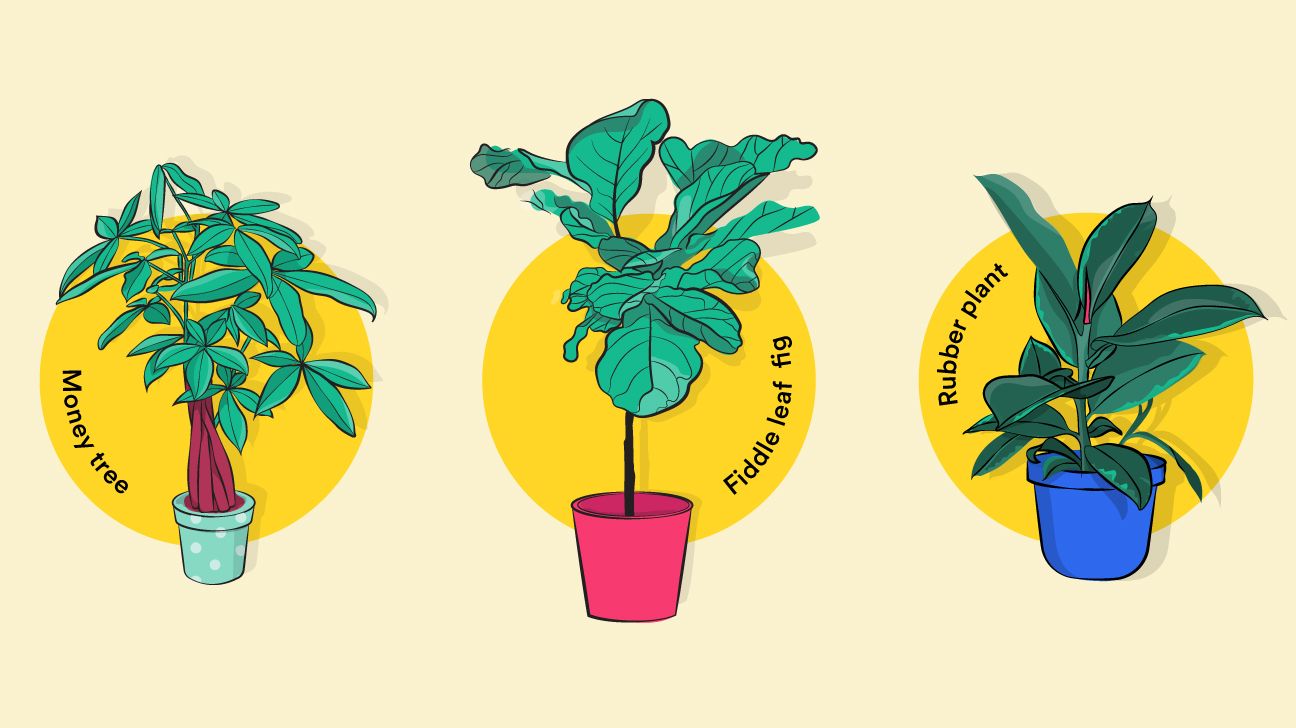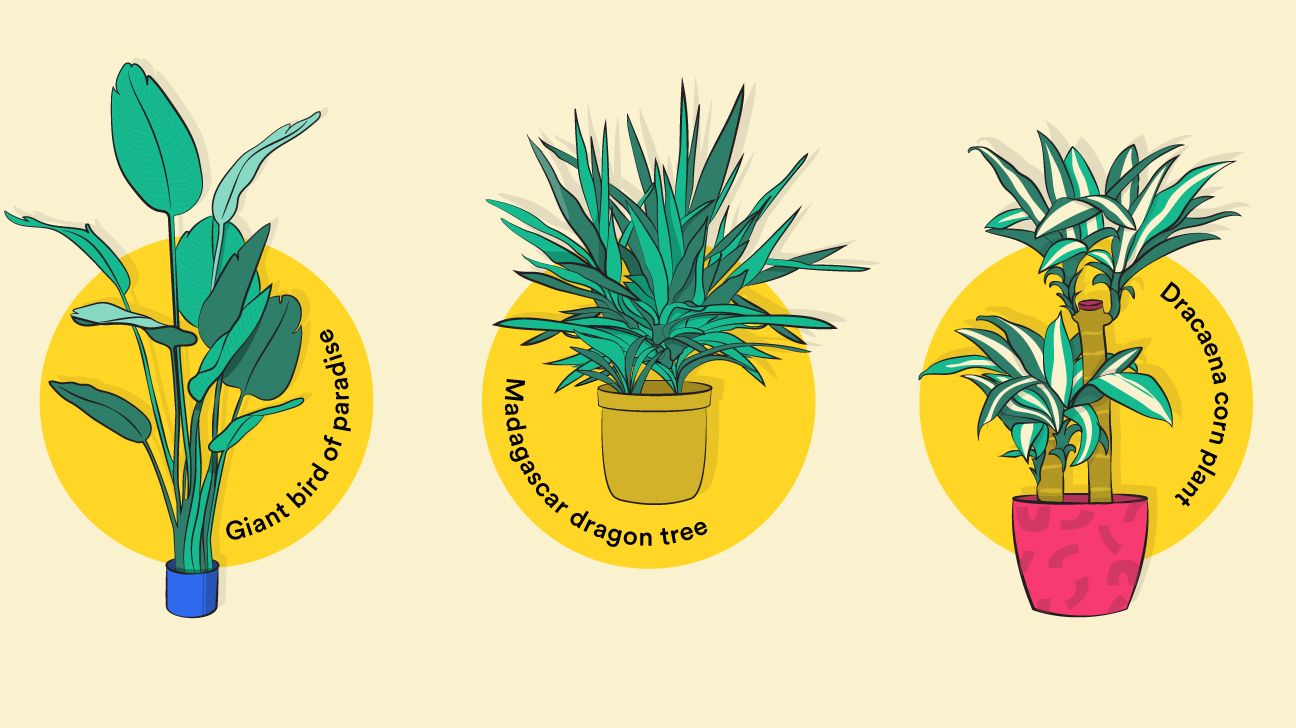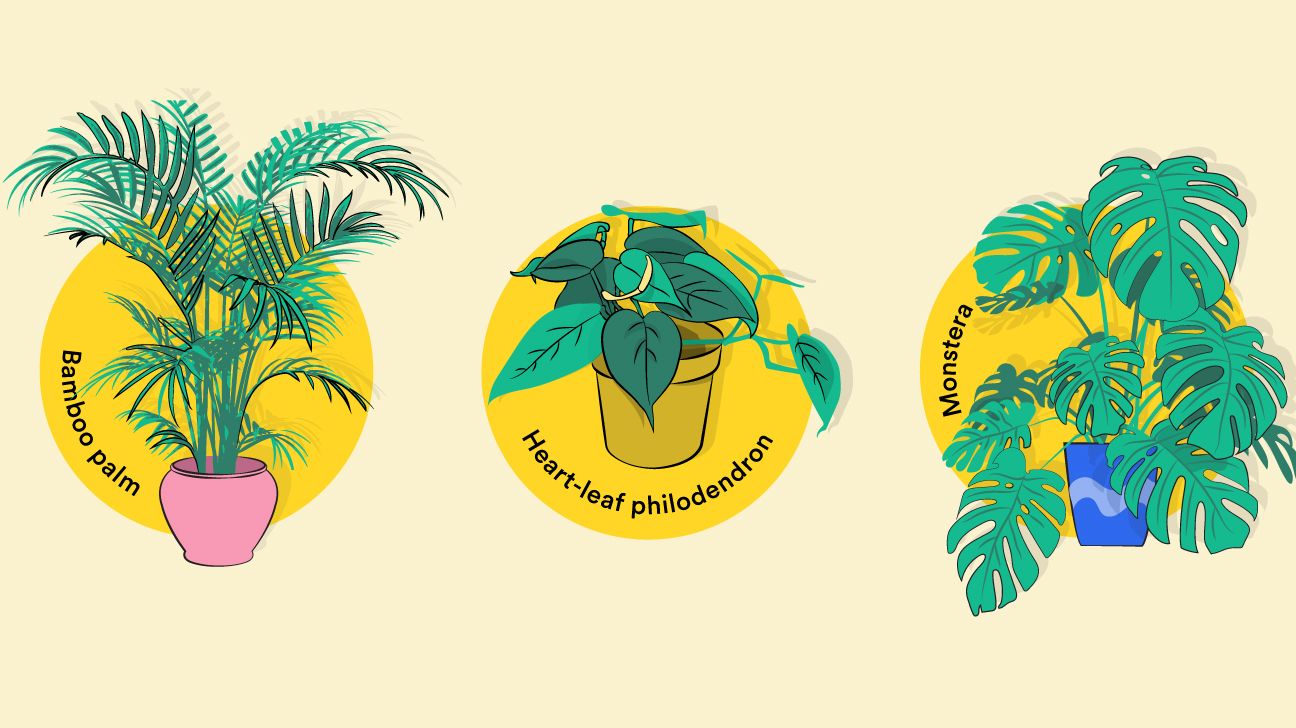We include products we think are useful for our readers. If you buy through links on this page, we may earn a small commission. Here’s our process.
Greatist only shows you brands and products that we stand behind.
Our team thoroughly researches and evaluates the recommendations we make on our site. To establish that the product manufacturers addressed safety and efficacy standards, we:- Evaluate ingredients and composition: Do they have the potential to cause harm?
- Fact-check all health claims: Do they align with the current body of scientific evidence?
- Assess the brand: Does it operate with integrity and adhere to industry best practices?
Who doesn’t love a good houseplant? Even if you’re a seasoned plant killer, those green bébés are just too hard to resist.
Indoor plants are a simple way to add a pop of color or boost the outdoor vibes in any room (especially if you’ve been stuck in said room for months). Plus, indoor plants are also just plain good for your mental health and make you feel better. We’ll take all the plants, please.
Here’s a list of 21 types of indoor plants, large and small. Get those green thumbs ready, we’re hopping on the plant parent train.

1. Money tree (Pachira aquatica)
We’re just as disappointed this isn’t the Sims’ money tree 🤑, but IRL the money tree is a symbol of positive energy, luck, and prosperity. Who doesn’t want that?
Light: Bright, indirect lights. Thrives in fluorescent lighting (perfect for apartment living).
Water: Water when the soil is almost completely dry at top.
Pet friendly: Yes.
Plant parent level: Beginner to intermediate.
Pro tip: Wipe any accumulated dust off the leaves.
2. Fiddle leaf fig (Ficus lyrata)
The fiddle leaf fig is an instagram plant fave and great decor for a boring corner. With its glossy, dark leaves, it acts as an extra statement piece to any room.
Light: Place it in a well-lit spot where it will receive indirect lighting all day long.
Water: Keep the soil moist, but let at least 1 inch of soil dry out before watering again. During the summer it requires more frequent watering.
Pet friendly: No. It’s toxic if cats or dogs ingest it.
Plant parent level: Intermediate. The fiddle leaf fig can be quite the diva.
Pro tip: This plant loves it some humidity so giving it a good mist keeps it happy.
3. Rubber plant (Ficus elastica)
The rubber plant is the less finicky sister of the fiddle leaf that you can tame down to 1-foot tall with pruning. It’s deep, green leaves have a rubbery look that is v bold.
Light: Give this one bright light, but not direct sunlight.
Water: Try watering it about 1 to 2 times a week (yellow leaves = lay off the water). Let the soil dry on top before watering. Make sure to really keep it moist during the summer, which is when it thrives.
Pet friendly: No. It’s poisonous to pets and humans if eaten.
Plant parent level: Beginner.
Pro tip: If you want new leaf growth after leaves have fallen off, cut a small notch in the node where the leaf fell from.

4. Giant bird of paradise (Strelitzia nicolai)
Another tropical fave, the giant bird of paradise plant has tall stems with banana-like leaves. Flowers can develop, but unfortunately they don’t typically appear indoors.
Light: It enjoys bright, indirect light. Too much direct light can damage leaves and flowers.
Water: Keep soil moist. In colder months, let the soil dry out more before watering.
Pet friendly: No. This plant is toxic to felines and fido.
Plant parent level: Beginner.
Pro tip: Rotate the plant every so often for optimal growth.
5. Madagascar dragon tree (Dracaena marginata)
We love a good low-maintenance plant, and one of the most popular is the Madagascar dragon tree. This plant has great architectural leaves, curving as it grows for a tropical look. Bust out the kiddie pool and mojitos, who needs a real vacation, anyway 🍹.
Light: Set this on in moderate to bright, indirect light.
Water: Water when soil dries out at top. Leaves will turn black if overwatered.
Pet friendly: No. Sap is toxic to animals.
Plant Parent Level: Beginner to intermediate.
Pro tip: Overwatering this plant can be tempting, but just let it live.
6. Dracaena corn plant (Dracaena massangeana)
The dracaena corn plant is easy to maintain, and with its yellow and green leaves, it can brighten up your living space. This plant also made the list of air-filtering plants from the NASA clean air study.
Light: It loves bright, indirect light, and fluorescent lighting. Avoid direct sunlight.
Water: Water when soil becomes slightly dry at the top. Be sure not to overwater because the tips will turn brown.
Pet friendly: No. Toxic to animals.
Plant parent level: Beginner.
Pro tip: Don’t use leaf shine on corn plants. They’re not a fan.

7. Bamboo palm (Chamaedorea seifrizii)
We love some tropical vibes (seeing a pattern? 🌴). The bamboo palm is one of the easier palms to take care of, and adapts easily to its environment. So if sunlight is an issue, we’ve got you. Plus, add it to the list of air purifying plants.
Light: This plant likes all lighting except direct sunlight.
Water: Keep soil moist, but be sure to have drainage for the plant. It doesn’t like too much water.
Pet friendly: Yes.
Plant parent level: Beginner.
Pro tip: Overwatering is the bamboo palm killer. It hates soggy soil. If you have a history neglecting plants, the bamboo palm is definitely for you.
8. Heartleaf philodendron (Philodendron hederaceum)
This is a go-to gift for birthdays, weddings, and anniversaries due to its heart-shaped leaves 💚 (what better way to show your love than a plant!). It loves to climb and makes a great hanging plant, plus it’s also very hard to kill. New plant parents rejoice!
Light: It likes medium light, but can tolerate bright, indirect light.
Water: Keep soil moist at all times.
Pet friendly: No. This plant is poisonous to cats and dogs.
Plant parent level: Beginner.
Pro tip: You can keep this plant small if you don’t have the space to let it grow. Just trim it down.
9. Monstera (Monstera deliciosa)
Also known as the Swiss cheese plant for its holes, the Monstera is iconic from many 70’s photographs, album covers, or advertisements.
With its aerial roots, the Monsteraloves to climb and spread out. Be sure to place it somewhere where it can take up some room. Buyer beware: This plant is pricey and will set you back a few bucks.
Light: Give it bright, indirect light. Avoid placing it in direct sunlight.
Water: Water whenever the soil starts to dry out.
Pet friendly: No. This plant is poisonous.
Plant parent level: Beginner.
Pro tip: Occasionally wipe leaves off for any dust particles.
10. Polka dot plant (Hypoestes phyllostachya)
Need some color to brighten up a drab room? The polka dot plant comes in a variety or colors, but is often known for its pink spots.
Light: Indirect sunlight is best, but direct sunlight during the day works if the plant doesn’t have much color yet.
Water: Well-drained and moist soil.
Pet friendly: Yes.
Plant parent level: Beginner to intermediate.
Pro tip: They aren’t too difficult to grow, but they do have a shorter lifespan compared to most plants. Keeping this plant indoors actually prolongs its life.
11. Calathea beauty star (Calathea ornata)
This is a great beginner plant. It’s easy to maintain once you find the right spot, and it can brighten up just about any room you want with its vivid colors.
Light: Medium light is preferred, so try near a window.
Water: Water it weekly, and allow soil to almost completely dry between waterings.
Pet friendly: Yes.
Plant parent level: Beginner.
Pro tip: Experiment around your house for the best spot for the plant, and if it’s leaves curl it’s thirsty!
12. Rattlesnake plant (Calathea lancifolia)
As part of the Calathea family, the rattlesnake plant shows off pale and dark green, wavy leaves. It’s definitely a unique looking plant you’ll want to have in your little plant oasis (snakes not included 🐍).
Light: This one needs plenty of diffused lighting. Direct sunlight will cause leaves to lose their color. The better the light, the better the foliage.
Water: Maintain damp soil at all times, and don’t let it sit in water.
Pet friendly: Yes.
Plant parent level: Beginner or intermediate.
Pro tip: Search for the best lighting location for this plant to thrive. It might take a few tries.
13. Snake plant (Dracaena trifasciata)
Also known as Sansevieria or mother-in-law’s tongue (yikes 😂), the snake plant can easily adapt to wherever you place it. It’s also an air purifying plant and an all-around great plant for newbie plant parents.
Light: This one does best in moderate to bright, indirect light, but it can adapt to low light.
Water: Allow soil to dry out before watering, and be sure to drain. It will rot if it sits in water.
Pet friendly: No.
Plant parent level: Beginner.
Pro tip: This plant produces oxygen at night and doesn’t need a lot of light, so it makes a great bedroom plant.
14. Spider plant (Chlorophytum comosum)
The spider plant name originates from the look of the plant’s slender leaves spilling over and creating other little plantlets (we promise no actual spiders).
It also loves moisture and is the perfect plant to stick in the bathroom. Plus it’s great for air purifying (another check for a perfect bathroom plant).
Light: Give it bright, indirect light. Avoid direct sunlight.
Water: Keep well-watered, but water less in the winter.
Pet friendly: Yes, but it can be mildly hallucinogenic to cats (like catnip). Still, it’s recommended to keep away from cats as it can cause an upset stomach, vomiting, or diarrhea.
Plant parent level: Beginner.
Pro tip: You can also create a second plant with baby spider plants. The baby spiders can be pressed down into compost, creating a self-root, giving you a second plant.
15. Zenzi ZZ (Zamioculcas zamiifolia)
The Zenzi ZZ plant is the little sib of the larger ZZ plant. With its dark green leaves and thick stems, it’s perfect as a desk plant (plus, it might make you want to go to work!).
Light: It does best in a shaded area. Avoid direct sunlight.
Water: It’s drought tolerant so only water whenever the soil starts to dry out.
Pet friendly: No.
Plant parent level: Beginner.
Pro tip: Less water is better for this little guy. Too much water can make its stem and roots rot.
16. Marble queen pothos (Epipremnum aureum)
The marble queen is a popular variety in the pothos family and is also called devil’s ivy. It’s green leaves can have a white or yellow marbling, and it’s long vines like to climb, making it a great hanging plant.
Light: It likes low light, but grows faster in medium to bright indirect light.
Water: Keep the soil on the dry side. If leaves turn black, you’re overwatering; if the leaves turn yellow, you’re underwatering.
Pet friendly: No. Toxic to cats and dogs.
Plant parent level: Beginner.
Pro tip: No ceiling real estate available for a hanging plant? You can drape a pothos on a table.
17. Jade pothos (Epipremnum aureum ‘Jade’)
Can you ever have too many hanging pothos plants? Another variation of the pothos plant is the jade pothos. Because it’s still a pothos, this plant is great for beginners, but unlike the marble queen it has vibrant green leaves.
Light: Can tolerate low light and be kept far from a window.
Water: Water weekly. Allow soil to almost completely dry between waterings.
Pet friendly: No. Toxic to cats and dogs.
Plant parent level: Beginner.
Pro tip: If you don’t want hanging vines, you can trim the plant.
18. Chinese evergreen (Aglaonema)
This plant requires little effort to take care of, making it a lovely beginner plant. It’s also a well-known air cleaning and purifying plant. Two great reasons to own one.
Light: Medium to low light.
Water: Make sure the soil is thoroughly moist when watered, and allow drying out between watering.
Pet friendly: No. This plant is toxic to pets.
Plant parent level: Beginner.
Pro tip: Chinese evergreens love warm temperatures and humidity so find it a spot that has both.
19. String of pearls (Senecio rowleyanus)
This plant has a trail of oval “beads” that makes the succulent unique. It’s a fast growing plant, so give it room to grow. It works great in hanging baskets or on shelves.
Light: Bright, indirect lighting.
Water: It’s drought tolerant due to storing water in its leaves. Let soil dry out before watering.
Pet friendly: No. Not safe for pets if ingested.
Plant parent level: Beginner.
Pro tip: You can trim the length if the “bead trails” become too long.
20. Sansevieria starfish (Sansevieria cylindrica)
Also called the starfish snake plant, this fanned out succulent looks like a baby snake plant (and that’s because they’re actually related!). It’s great if you have limited space and is pretty easy to take care of.
Light: Place it in low light, far from a window
Water: Water every other week.
Pet friendly: No. Bad for pets if ingested.
Plant parent level: Beginner.
Pro tip: Experiment around your house for the best spot for the plant.
21. Aloe vera (Aloe barbadensis)
Aloe vera is a gift for skin, especially if you’re sunburnt. The stemless succulent is known for its healing and air purification properties, and it’s super hard to kill. It also just looks great placed on shelving and windowsills.
Light: Bright, indirect sunlight.
Water: It does well in dry conditions so water sparingly. It does not like excess water, so use a planter with a drainage hole.
Pet friendly: Yes.
Plant parent level: Beginner.
Pro tip: Leaves turning brown? Cut them off to help the plant stay healthy. If you want to DIY aloe gel for your skin, just cut off a leaf and seperate the gel from the stalk.
Check yourself. There are a few factors to consider when picking the best indoor plant for you.
Think about the lighting situation in your home
- Do you have a lot of windows?
- How many hours of sunlight does one window provide?
- Would you consider your light situation bright, moderate, or low-light?
South-facing windows contain the brightest light, and the farther away from the window you are, the less natural light you’ll get.
When in doubt about the best window, get your compass out (there’s likely one on your phone) and feel it out. If you have low light, consider a low-light plant.
Consider how much time you spend at home or travel
- Will you have enough time to care for certain plants?
- Do you travel for weeks at a time?
- Do you already forget to water plants?
If you’re neglectful, look for plants that can tolerate not being watered for up to 2 weeks.
Be careful where you put your plant
- Do you have cool drafts?
- Do you have a hot radiator?
- Do you have an HVAC vent that really pumps in the heat or cold air?
Keep most plants away from these areas to help them thrive.

